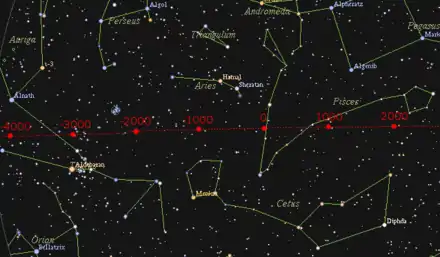
Ayanamsa (ayanāṃśa: from Sanskrit ayana 'movement', and aṃśa 'component'), also ayanabhāga (from Sanskrit bhāga 'portion'), is the Sanskrit term for many systems used in Hindu astrology to account for the precession of equinoxes.[1] There are also systems of ayanamsa used in Western sidereal astrology, such as the Fagan/Bradley Ayanamsa.[2]
Overview
There are various systems of Ayanamsa that are in use in Hindu astrology (also known as Vedic astrology) such as the Raman Ayanamsa[3] and the Krishnamurthy Ayanamsa,[1] but the Lahiri Ayanamsa, named after its inventor, astronomer N.C. Lahiri, is by far the most prevalent system in India.[2][4] Critics of Lahiri Ayanamsa have proposed an ayanamsa called True Chitra Paksha Ayanamsa.[2][4] There are other existing ayanamsa such as Raman, Pushya Paksha, Rohini, Kërr A.I, Usha Shashi and Chandra Hari.
The use of ayanamsa to account for the precession of equinoxes is believed to have been defined in Vedic texts at least 2,500 years before the Greek astronomer Hipparchus quantified the precession of equinoxes in 127 B.C.
See also
References
- 1 2 Barbara Pijan, https://barbarapijan.com/bpa/Amsha/Ayanamsha.htm
- 1 2 3 "Ayanamshas in Sidereal Astrology". www.astro.com. Retrieved 5 December 2019.
- ↑ "Saravali: Ayanamsa". www.saravali.de. Retrieved 5 December 2019.
- 1 2 Mihira, Varaha (4 February 2016). "Which Ayanamsa did Sri Varahamihira use?". Medium. Retrieved 31 March 2020.
External links

.png.webp)